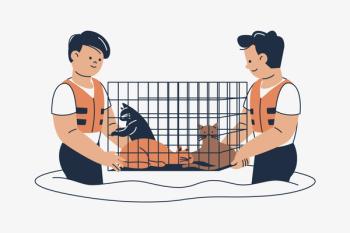
A former DEA agent on what veterinarians need to know about DEA compliance
The Drug Enforcement Administration is auditing veterinary clinics more frequently than before, explains Jack Teitelman, CEO of a DEA regulatory consulting firm, in this Q&A.
Jack Teitelman is a retired Drug Enforcement Administration (DEA) Supervisory Special Agent with more than 26 years of experience investigating and dismantling narcotics trafficking organizations in the US and internationally. Following a distinguished DEA career that included leadership roles in electronic surveillance, complex criminal investigations, and the New York Organized Crime Drug Enforcement Strike Force, Teitelman now serves as president and founder of TITAN Group, a regulatory consulting firm specializing in DEA compliance in animal and human healthcare. Over the past 9 years or so, he has worked as a pharmaceutical expert on the legal side, working with veterinarians, manufacturers, distributors, and healthcare professionals to provide regulatory compliance services.
In this interview with dvm360, Teitelman breaks down what veterinarians need to know about DEA compliance. He explains how veterinary practices have now become a formal part of the DEA’s annual work plan, why audits are occurring more frequently than ever before, and what clinics must do to avoid the most common compliance pitfalls.
This interview has been edited and condensed for clarity.
dvm360: What are some of the best DEA practices for managing controlled substances in veterinary clinics?
Teitelman: I [recently] gave a talk to the Connecticut [Veterinary Medical Association]. At the end of the webinar, there’s a slide that says: reconcile, reconcile, reconcile. That is the most important thing you can do: keeping up with your record keeping.
Security [is also important]: if you don’t have an alarm system, get one; if you don’t have cameras covering all pertinent areas where you store controlled substances, get them. These are all pain points the DEA [looks at] when things go wrong—they’re going to ask, “Why didn’t you have this? Why didn’t you have that?” And you should [have it]. It's all in your Bible—the [Code of Federal Regulations] (CFR).
Reconciling is a little different from counting. Counting is part of it, but [you need to] make sure you have consistent cycle counts—whether you do it on a daily basis, weekly, quarterly, [you must] do it. If you haven’t done a biennial inventory, do it today. These are all things that DEA expects you to have ready and retrievable for them when they walk in the door...so you have to be prepared for them.
Reconciling is [the] number 1 [best practice.] Being proactive is number 2. Being proactive means understanding what it is that you're buying and how you manage it. [It’s also knowing] how you balance [substances], what you bought, what used, what you have on hand, and what you sold. It's very simple math, but it gets out of hand as time goes by.
dvm360: How should controlled substances be appropriately stored and dispensed?
Teitelman: According to the DEA, they have to be stored in a substantially constructed device. The easiest way [to do this] if you don't have a large amount of drugs is go to Home Depot and buy a small gun safe—those are easy to secure; it has to be secured. You can put 2 lag bolts in and you’ve met the standard of a storage.
If you have a larger inventory, you’re better off buying a large, 750-lb safe that can't be carried out. And if you're using a refrigerator to store drugs, make sure the refrigerator is also secure and that you have ancillary storage inside that refrigerator.
Just be cognizant of how easy it would be to break into it. That used to be my job at the DEA when I was in a group that did break ins and put bugs in people's houses and cameras. Some were easy to get into because people didn't secure [properly]. [Proper] hardware, Medeco-type locks, [and] technology like automated dispensing systems [can help].
dvm360: What are some common mistakes veterinary professionals make with controlled substances?
Teitelman: [One major mistake is failing to document the “life story” of a pill.] The DEA is following the life story of one pill. Let’s use Tramadol, for example. [DEA] is at the manufacturing facility that makes Tramadol. They're stress testing that manufacturer to make sure that they bought to synthetically make that [pill] is being managed correctly. Then they follow that one pill to the drug distributor—one of the big drug suppliers that you're buying from. Again, they [get] stress tested by the DEA [questioning], “[how many Tramadol pills] did you buy?”
And they're going to go through the same test when that one pill now gets sold to you as the veterinarian. What [often] goes wrong there is the story ends there. There’s no documentation about when that one pill came in, who signed for it. What did you do with that one pill when it came in? Was it put in backstop? Was it immediately given to a patient because you owed the patient pills? Failing to negotiate and complete the basic purchase records the DEA expect you to have is the biggest failure we see. Without this, the DEA can’t verify your inventory.
Accurate tracking of those purchases [and] keeping a perpetual inventory of all of your purchases is vital to passing a DEA inspection. So, if you don't have a logbook of what you bought and then where that went from the beginning, you’re going to fail DEA’s accountability audit when they come in.
dvm360: How often are veterinary clinics audited by the DEA?
Teitelman: ...Your chances of [DEA] coming are so much higher now than ever before. Audits are happening more often now than ever. DEA investigators’ fiscal year starts October 1, and...veterinarians are now part of the work plan for every DEA investigator.
Why is DEA showing up more than they've ever done before? Well, A) it's their job. And B) veterinarians are challenging in in the sense that you use controlled substances unlike anybody else. You're using human drugs off label. You're using them for different purposes. You're putting them into compounds. You're making [constant rate infusion] (CRI) mixtures that sometimes get used across multiple patients. So, there are lots of things that need to be addressed when we're in a veterinary clinic that aren't addressed on the human side,
[TITAN Group] understands the challenges of dealing with injectable medications. That is something that DEA is not used to dealing with. They're used to dealing with the unit doses that they see in a hospital: pills. Pills are easy to count, right? When you have liquid, have injectables, that becomes different. Then you don't know what you started with.
And then there are all the different usages of different needle-size gauge needles that get used. It [messes] things up when we try to track hub loss [and] can make it look like we're missing stuff when we're really not. And so, we have to be able to explain that to the DEA agents: no, we're not missing a bottle—it’s because of x. When we track all of that and we see variances, [we] can prove why it looks like we have a loss when we really don’t. That’s why we haven’t reported it.
So, being consistent in how you do your record keeping goes a long way. Even if your record keeping [isn’t great], if you're consistent, sometimes that gives us a shot at finding where the issues are.
Newsletter
From exam room tips to practice management insights, get trusted veterinary news delivered straight to your inbox—subscribe to dvm360.






